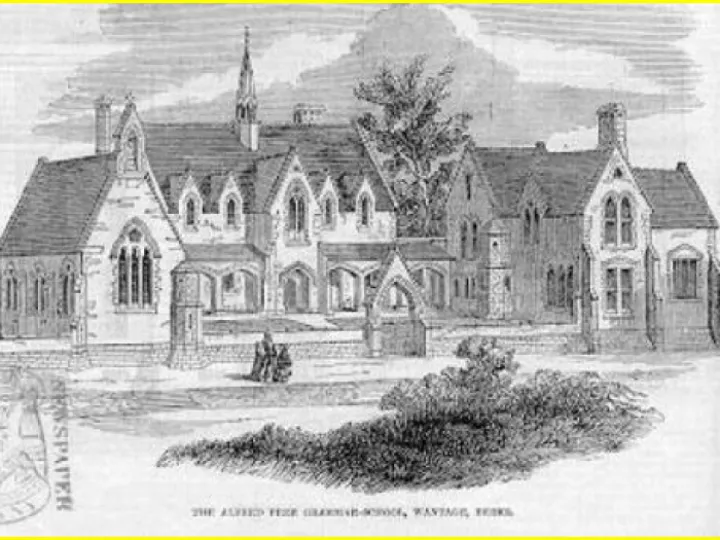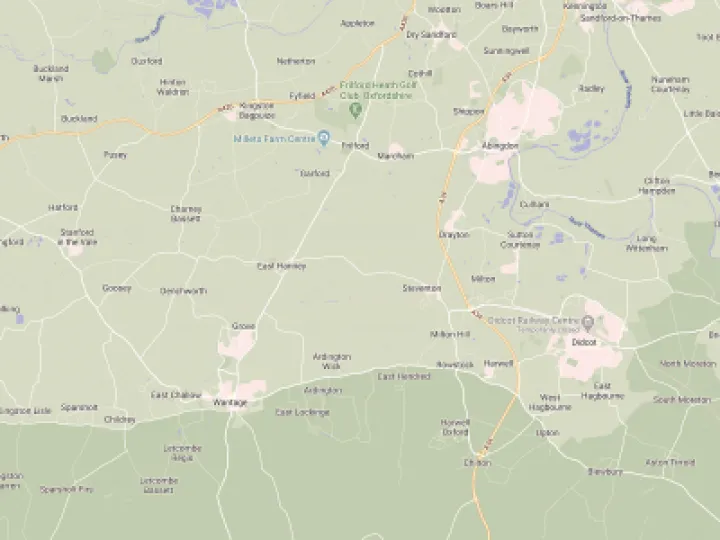Schools in Wantage
Schools in Wantage
By Mike Haddrell
As this is a longer piece about the schools, the recording is split into two parts. The first is about the founding of King Alfred's School. The second is about the history of schools in Wantage from 1434 to the present day.
More information about the history of schools in Wantage can be found here: Old Fredians
Mike's full article about schools in Wantage can be found here: Bonus
The first recording can be heard here: Founding of King Alfred's School
The second recording can be heard here: Schools in Wantage from 1434 to the present day
{The full text is as follows:
}Hi! I'm Mike Haddrell, Secretary of the Alfredians' Club, for former students of King Alfred's. I'd like to tell you a bit the history of Wantage's schools, especially King Alfred's.
The inscription on the statue of King Alfred in Wantage Market Place begins "Alfred found learning dead and he restored it. Education neglected and he revived it." King Alfred's School was named after him. Is there any evidence that he founded it?
The book Wantage Past and Present tells us that in the reign of King Alfred "Schools were opened in all directions." Alfred recruited teachers from abroad, from France and from Ireland.
He established a "court school" attended by his children, Edward and Aelfthryth, and others of noble birth. It moved with him when he travelled around the kingdom and if he visited his birthplace it might have appeared in Wantage. Alfred's youngest son Aethelward attended a different school, which also educated children who were not noble, and used books in Saxon as well as Latin. Were either of these our King Alfred's School?
In Alfred's day all education had its roots in religious foundations and he established monasteries at Shaftesbury and Athelney and the New Minster at Winchester. These locations are well south and west of Wantage – a safe distance from the Guthrum's Viking Kingdom, to which Wantage was just a little too close. In Alfred's reign there was no Oxford University nearby, the monastic revival was still a century away and his priorities lay in educating his courtiers and defending Wessex against the Danes. I'm afraid to say it seems unlikely that he managed to find time to set up a school in Wantage – even though he was born here!
There was once a Public School for Girls in Wantage, St Mary's, which celebrates among its former pupils the great granddaughter of King George V, Lady Helen Windsor. It was founded in 1873 and closed in 2007. The Chapel in Newbury Street now houses an NHS dentist, other buildings were converted to flats, and housing has been built across the site.
There are other ghost sites which once hosted learning. Housing now occupies the site of Wantage County Primary School, Garston Lane where Wantage's youngsters learned and played from 1929 to 1999.
In the late 18th early 19th centuries there was a school at the Priory, opposite the Church on the corner of Priory Road. In the 1850s St Michael's in Priory Road, provided girls with training for domestic service, later training teachers and then missionary students, before being converted for private housing towards the end of the 20th Century.
In Church Street the former Cof E Infants school, now houses pre-schools. It started life in 1850 as a National School. Further up Church Street a Gothic Stone archway led to the now demolished Methodist school. In the 1860s there was a School for Young Ladies at Vale House (later Brooklands) in Newbury Street, run by two sisters Eliza and Emma Bugbird.
Around the same time a girls' school was founded in Church Street, moving to Newbury Street in 1894 as St Katherine's School. In 1898 it moved to new buildings in Ormond Road. The school went in 1938 when St Katharine's merged with St Helen's in Abingdon. St Katherine's Care Home now occupies the site, but the grand 1898 buildings are no more.
Thanet House in Newbury Street was used by boarders from King Alfreds in the 1920s and in 1933 it became the prep school for KAs, attended most famously by Lester Piggott. It closed in 1950.
Another building which has sustained its educational focus is Rockwell House, where in 1950 Miss Barbara Clarke founded St Andrew's School, a private primary school for boys and girls. The school closed in 2010. The building now houses Rockwell House Day Nursery or "Busy Bees."
Opposite Rockwell House stands Alton House, 29 Wallingford Street, where in the second part of the 19th Century Misses Caroline, Annie and Florence Bailey founded a school. It usually had around 50 boys and girls and later moved to a site on the corner of Newbury Street and Ormond Road. In the 1920s and 1930s it used upstairs rooms at what is now Green & Co estate agents and at the VC Gallery
Our main focus here is Wantage's current secondary school, King Alfred's. In 1983 a commemorative mug marked the amalgamation of Wantage's three secondary schools, King Alfred's, Icknield and Segsbury. It bore the legend "King Alfred's School 1434 to 1983."
In his History of Wantage School, published in 1924, former Headteacher K.A.R. Sugden suggests that because the Priory of Ogbourne in Wiltshire, which supplied the priest for Wantage, closed in 1434, the town must have had to make its own arrangements for education, and so founded Wantage School! I can find no other evidence to justify the foundation date on our commemorative mug.
The school's charter mentions money being left by "sundry persons" for maintaining a schoolmaster in the town "in the time of the late King Henry the Sixth" who became king in December 1421. This seems to be the only basis for the suggestion that the school dates from 1422.
In 1534 John Leland, Henry VIII's librarian, visited Wantage, where he noted in the Churchyard 'an ancient building now used as a school.' This was almost certainly the Chapel of St Mary which stood in the churchyard where the war memorial now is.
In 1597 An Act of Parliament established the Governors of The Town Lands with a responsibility for maintaining a Schoolmaster to teach grammar in Wantage. Over the years the Governors of The Town Lands managed two schools in Wantage in addition to the Grammar School. The English School or Pettischool stood behind the Church, in the late 18th Century and there was also a Girls' School. Neither were in continuous use from 1597.
In 1849, the millenary of King Alfred's Birth provided the impetus for Wantage's new and energetic Vicar, Reverend William John Butler, to take the lead in building a new Grammar School. The ancient building in the Churchyard went in 1850. Somewhere in the rubble was a stone Norman door arch which was incorporated into the new Schoolroom. A two-storey symmetrical building at the end of the Sacred Way provided the boys' dining room and classroom, with a dormitory above, and the Headmaster's House at the eastern end. These original buildings were extended in the 1860s, 70s and 80s to provide the Victorian core which survives on Centre Site.
The large classroom at the northern end of the quad, built in 1872, was used in the later 20th Century as the school hall, then a library and resources centre. In 1897-9 science buildings, including a laboratory, a workshop and an art room were built by the Priory Road entrance, rooms 1-5 known as The Gods and demolished in 1974. In 1910 the Governors bought the town Fire Station on the south side of Portway and converted it to armoury for the Officer Training Corp. This building still stands, unlike the adjacent Rooms 6, 7 and 8, built in 1921 and demolished to make way for the 1979 Sixth Form Centre '
In 1922 The Alfredians presented the Lych Gate to the school in remembrance of those killed in the First World War. In 1949 the Second World War Memorial was set in the wall over the entrance at the end of the Sacred Way. The War Memorial Pavilion, opened on May 12 1955, was moved to Hanney Cricket Club in 1999.
In 1951 rooms 9 and 10, for Art and Geography, were built next to the 1913 gym in the middle of Centre Site. Neither the classrooms nor the gym remain.
Autumn Term 1960 saw a new House Block (Bailey, Butler and Lloyd) on Centre Site and a two-storey science block with a library and art room on the ground floor. These have all gone but the 1970s Four Storey Block, Science Labs, School Hall and Technical & Arts Block remain, refurbished and adapted in the 2010s.
In 1938 Berkshire County Council bought the army huts in Springfield Road which, in September 1949 became The Secondary Modern Department, an annex to Garston Lane Primary School. The Ministry of Education developed the site and a new school, Icknield, received its first pupils on 25th May 1956. During its independent existence Icknield had three Headteachers: Mr Hurford, Mr Craggs and Mr Howells.
On September 17th 1963 Wantage gained a third secondary school, on the Challow Road. Mr Trendell was the first Headteacher of Segsbury, a Secondary Modern School for boys and girls. He retired in the early 1980s and was succeeded by Mr Collier. Today known as West Site, the campus is attended by King Alfred's pupils in Years 7 and 8.
In 1966 King Alfred's, Icknield and Segsbury agreed to become Comprehensive schools. Links between the three were forged from around 1972 and September 3rd 1974 saw the first intake of girls to the first year and Lower Sixth at King Alfred's, the first generation to be spared Saturday morning school, and the first comprehensive intake who started Secondary School without having taken the Eleven Plus.
In March 1979 the new Sixth Form Centre for all three Wantage Schools opened on the south side of Portway. In 1984 the three schools merged to become Wantage School, reverting to King Alfred's School in 1987. In 1999 King Alfred's became a Specialist Sports College and was known as King Alfred's Community and Sports College.
In 2012 new buildings at East Site (Icknield) included a classroom, science lab, music rooms and a fitness suite. After the closure of Icknield in 2017 these buildings were moved to West Site (Segsbury) as the Humanities Department. In March 2019 a brand new Sports Hall was opened on West Site.
On 25 April 2014 Prince Edward, and his wife Sophie, Countess of Wessex opened the Christopher Loyd Creative Arts building. It was the Prince's birthday! The same development phase saw the replacement of the House Rooms with a three-storey building providing 13 classrooms and a canteen.
In December 2017 Ed Vaizey MP opened the new two storey Science Block replacing the 1960s science building with high spec laboratories and classrooms. In September 2019 the Sixth Form Centre re-opened after major refurbishment.
Richard Evans is currently the Chief Executive of The Vale Academy Trust, which mnages King Alfred's among a number of other local schools. In a strange coincidence the offices of the Trust in Denchworth Road are based at St Mary's Convent, which was so influential in developing schools in Wantage in the middle of the 19th Century. King Alfred, The Governors of the Town Lands, The Community of St Mary the Virgin and the Reverend William John Butler have a successor.


